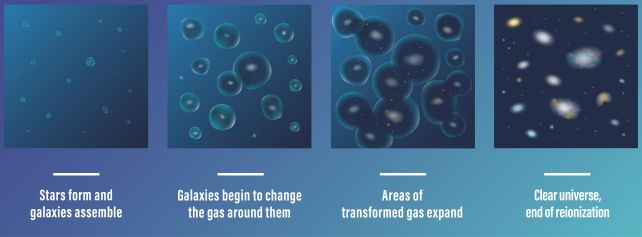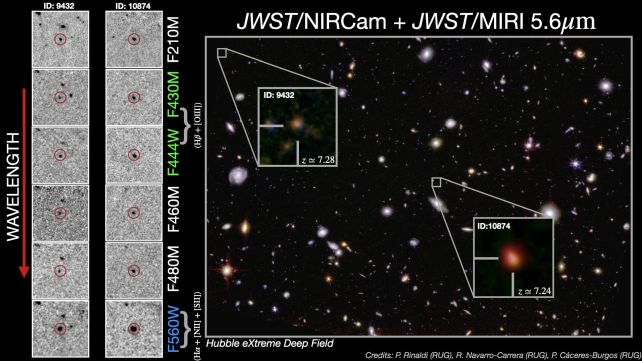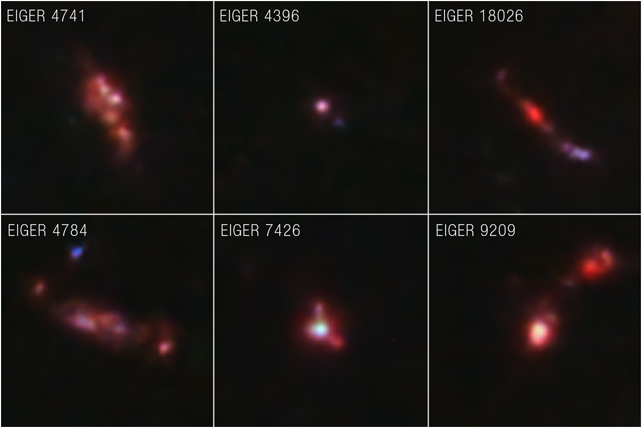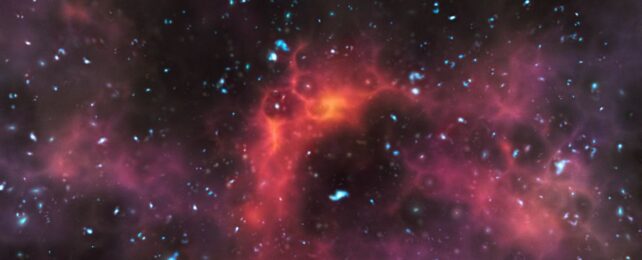Peering back into the distant past, astronomers are prying apart the secrets of when the Universe switched on its lights.
In four separate papers, accepted into or published in The Astrophysical Journal, scientists have detailed the deepest peek yet into the period known as the Epoch of Reionization – the period in which the thick fog that was obscuring light from propagating cleared, allowing stars and galaxies to finally shine.
Relatively little is known about this epoch, but the new observations, obtained using the James Webb Space Telescope, show that star formation was rife, and the light of this process played a significant role in clearing the clouds of the early Universe.
The research also collectively demonstrates the telescope's power in studying this enigmatic period in our Universe's history and understanding the processes taking place while everything was still a bit of a hot messy soup of matter.

Epoch of Recombination
Everything in the Universe seems relatively settled now, but the early Universe, in the first billion years after the Big Bang 13.8 billion years ago, was a time of rapid change. Initially, space was filled with a hot, murky fog of ionized gas. This gas was impenetrable to light; photons merely scattered off the free electrons flying around.
As the gas began to cool, protons and electrons began to combine to form mostly neutral hydrogen atoms, and some helium, in a period known as the Epoch of Recombination, around 300,000 years after the Big Bang (a slight misnomer since they hadn't been combined before, but that's what we call it).
That was the first of the major phase transitions experienced by gas in the early Universe. With all the free electrons bound up in atoms, light could move freely. There just… wasn't much around to make it, so space remained pretty dark.
Epoch of Reionization
The next phase of transition was reionization. Scientists believe clumps of neutral hydrogen started to form stars, grouped into galaxies, blasting the gaseous medium with ultraviolet light.
This reionized the gas by knocking electrons loose; however, because space had expanded quite a bit, the newly ionized hydrogen was diffuse enough to continue to allow light to stream. By about 1 billion years after the Big Bang, space was completely transparent.

However, it's tough to see what's going on during the Epoch of Reionization. It's very far away, the objects are very faint, and there is still a lot of opaque space, obscuring our view. This is where JWST comes in. The infrared space telescope was built with this period in mind, and its powerful gold-coated eye reveals signals of objects shining in the distant darkness.
In a preprint accepted by The Astrophysical Journal, an international team of astronomers led by Pierluigi Rinaldi of the University of Groningen in the Netherlands reveal the first Epoch of Reionization (EoR) detection of a specific wavelength of hydrogen, called hydrogen alpha.
This is a signature of star formation. Massive baby stars blast out a lot of ultraviolet radiation, which shines into the interstellar medium, ionizing the neutral hydrogen gas that may be hanging out there. This causes the hydrogen gas to glow in a specific wavelength – that's the hydrogen alpha line.
We don't know what produced the ultraviolet light in the EoR, whether it was stars, galaxies, or quasars, but the first detection of hydrogen alpha as it was going on is a strong clue. Rinaldi and his colleagues analyzed the signal and found that star formation is behind much of it.
"We concluded," they write, "that the strong hydrogen alpha emitters produced about a quarter of the total star formation rate density at [around 13 billion years ago], which suggests that they likely have had a significant role in the process of reionization."
A paper led by astronomer Daichi Kashino of Nagoya University in Japan adds to the story. Reionization was not a uniform process; it happened in pockets, or bubbles, around the brightest UV emitters, i.e., galaxies. Kashino and his colleagues used JWST data to discern these pockets, showing that galaxies also significantly contributed to the EoR.
"Not only does Webb clearly show that these transparent regions are found around galaxies, we've also measured how large they are," Kashino says. "With Webb's data, we are seeing galaxies reionize the gas around them."

These bubbles were around 4 million light-years across at the time the researchers targeted, towards the end of the EoR, and a paper led by astrophysicist Jorryt Matthee of ETH Zürich in Switzerland analyzed their characteristics. His team found that the galaxies were very hot, low in metals and dust, and very active.
"They are more chaotic than those in the nearby universe," Matthee says. "Webb shows they were actively forming stars and must have been shooting off many supernovae. They had quite an adventurous youth!"
A fourth paper, led by Anna-Christina Eilers from MIT in Cambridge, Massachusetts, focused not on reionization processes but the quasar galaxy at the center of the JWST observations.
These are among the brightest objects in the Universe, galaxies with an active supermassive black hole accreting so much matter that they blaze across time and space.

As this light travels to us from the Universe's distant reaches, it moves through gas. Analysis of the light can reveal a lot about what's in the space between here and there. The team's work also revealed that the quasar contains a supermassive black hole around 10 billion times the mass of the Sun. Exactly how it grew so large in just 1 billion years is challenging to explain, but that will be the subject of future work.
What we do know is that this is not the final word on the EoR. We've barely scratched the surface.
"This research opens up the possibility of studying early galaxies in a way not possible before," Rinaldi says. "The great thing is that we have shown that this kind of study can be done routinely with JWST/MIRI."
The four papers have been accepted into or published in The Astrophysical Journal Letters. They can be found here, here, here, and here.
